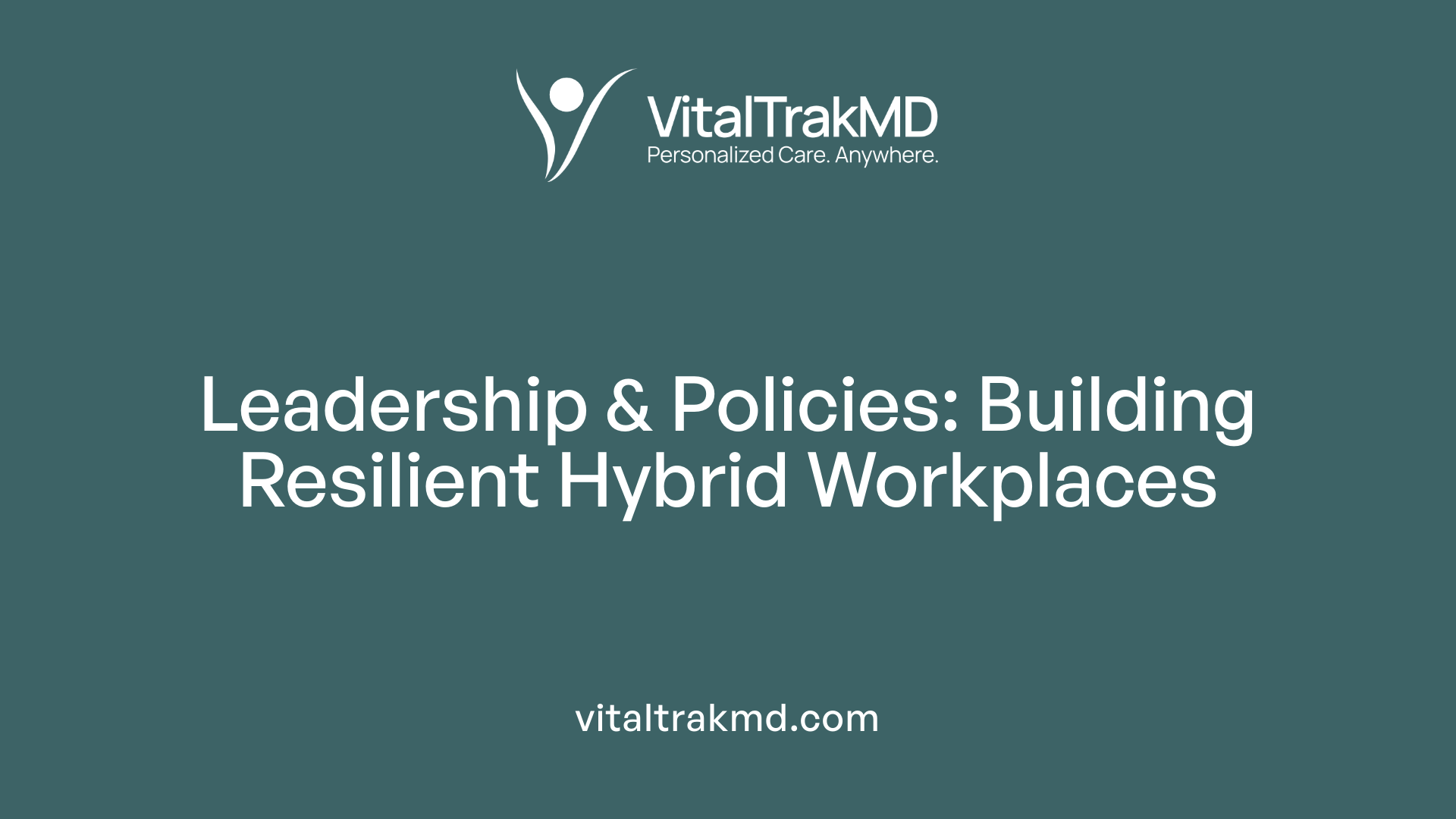No Energy for In-Person Consults? Go Hybrid with Support

Understanding Hybrid Work in the New Normal
As organizations and employees embrace hybrid work models, understanding the dynamics and challenges of this flexible approach is essential to maintaining productivity, wellbeing, and team cohesion. While hybrid work offers substantial benefits, it also introduces new hurdles such as burnout, fatigue, and communication barriers. This article explores comprehensive strategies to support hybrid workers, optimize organizational policies, and foster resilient work cultures.
The Rise of Hybrid Work and Its Impact

How has hybrid work grown after the pandemic?
Since the onset of COVID-19, hybrid work has transitioned from a temporary solution to a permanent fixture in many organizations. Surveys, such as one by McKinsey & Company, reveal that 87% of respondents value work flexibility, with only 32% favoring full remote setups. Additionally, over 75% of associations planned to evolve into hybrid or fully remote workplaces in 2022.
Organizations recognize hybrid work as an effective way to balance flexibility with in-person collaboration. This shift is driven by improvements in digital infrastructure and a desire to create more adaptable working environments.
What is the effect on employee productivity and satisfaction?
Employees generally report high productivity levels when working remotely; three-quarters of workers in countries like Germany, India, and the US say they perform as well or better at home. However, hybrid workers tend to experience more burnout symptoms—such as exhaustion and negative feelings—compared to in-person and remote-only colleagues.
This increased fatigue results from difficulties in managing boundaries between work and personal life, constant planning, frequent environment changes, and digital presenteeism. More than 80% of leaders and workers find hybrid arrangements emotionally draining, often leading to stress and fatigue.
How are organizations shifting towards hybrid models?
To support this new model, organizations are investing in digital tools, flexible policies, and hybrid collaboration frameworks. They focus on developing systems that enhance communication, trust, and team cohesion.
Effective hybrid models prioritize autonomy, clear role expectations, and inclusive communication channels. Leaders are trained to navigate remote and in-person teams effectively, fostering a positive, resilient organizational culture.
In summary, hybrid work’s growth post-pandemic is reshaping workplaces worldwide. While it offers flexibility and potential for higher productivity, it also presents challenges like burnout and disconnection that organizations are actively working to address through strategic planning and infrastructure investment.
Understanding Hybrid Work Models and Structures

Do hybrid work arrangements require employees to be physically present in the office?
Hybrid work does not mean you have to go into the office every day. It is a flexible work model that allows employees to choose where they work, including in-office, remote, or on-the-go settings. Different configurations exist within hybrid models, such as flexible, fixed, office-first, and remote-first structures.
Flexible models allow employees to decide on their schedule, blending remote and in-office days based on their preferences and job requirements. Fixed models may require employees to be in the office certain days each week, providing consistency. Office-first models prioritize physical presence, with optional remote work, while remote-first models primarily operate remotely with occasional in-office meetings.
Organizational policies supporting hybrid work focus on providing autonomy and establishing clear expectations. They include guidelines on work hours, communication protocols, and performance management that leverage technology for seamless collaboration. These policies are essential for maintaining productivity and fostering an inclusive culture.
The influence of hybrid work on workplace culture is substantial. It emphasizes trust, flexibility, and results-driven performance. Companies that implement effective hybrid structures often see increased employee satisfaction and engagement, fostering a resilient and adaptable organizational environment.
Summary Table of Hybrid Work Configurations and Policies:
| Configuration | Description | Typical Organizational Policies |
|---|---|---|
| Flexible | Employees choose when and where to work | Outcome-based performance, flexible hours, digital communication tools |
| Fixed | Pre-scheduled in-office days | Clear schedules, dedicated in-office days, technology support |
| Office-first | Primarily in-office with optional remote days | Emphasis on physical presence, core hours, virtual collaboration tools |
| Remote-first | Mostly remote with occasional in-office requirements | Embraces autonomy, cloud-based tools, regular virtual check-ins |
Hybrid work models are here to stay, reshaping how organizations approach workspace design, team management, and organizational policy. Successfully implementing hybrid work requires a strategic approach, emphasizing trust, clarity, and flexible policy frameworks.
The Exhaustion Paradox: Why Hybrid Work Can Be Draining

Why is hybrid work so exhausting?
Hybrid work, which combines remote and in-person arrangements, can often lead to significant fatigue for employees. This exhaustion stems from the constant need to adapt to fluctuating routines and changing environments. Employees are frequently shifting between their home space and the office, which disrupts their daily flow and routines, leading to increased mental strain.
One of the main challenges is the blurring of boundaries between work and personal life. When employees do not have clear separation, it becomes difficult to disconnect after work hours, contributing to feelings of being perpetually 'on' and exhausted.
Managing a mix of virtual meetings, in-person collaborations, and independent tasks can be overwhelming. The demand to be flexible while juggling these responsibilities often results in multitasking, which is mentally taxing.
Furthermore, hybrid workers might feel isolated or disconnected from colleagues, missing out on informal interactions that foster team cohesion. This social gap can impact emotional well-being over time.
While hybrid work offers workers flexibility and reduces commute times, many find that it introduces new stressors. The complexity of switching between different work modes and environments imposes a mental load that, if unmanaged, can lead to burnout.
In essence, the hybrid model's demands—constant adjustments, boundary management, and social navigation—are the main reasons employees might experience fatigue, despite its potential for increased flexibility and work-life balance.
Supporting Hybrid Workers to Prevent Burnout

How can organizations support employees with hybrid work-related exhaustion?
Hybrid work has become a prevalent model, offering flexibility but also raising concerns about employee burnout. To address this, organizations need to adopt effective strategies that help workers manage stress and fatigue.
One of the first steps is establishing clear boundaries around work hours. Designating specific times for work and encouraging 'quiet hours' can prevent work from spilling into personal life. This helps employees disconnect and recharge, reducing feelings of exhaustion.
Encouraging regular mental health days is vital. Providing employees with time off to focus on their well-being shows support and fosters a culture of trust. Open communication channels where staff feel safe to share their struggles can significantly lessen feelings of guilt, isolation, or overwhelm.
Promoting social interactions, whether through virtual coffee breaks, team-building activities, or in-person gatherings, also helps alleviate loneliness. These micro-connections foster a sense of belonging and strengthen team cohesion.
Performance metrics should be outcome-based rather than hours logged, allowing employees to focus on results rather than clocking in long hours. Offering access to mental health resources, such as counseling services or wellness programs, provides additional support.
Finally, involving employees in the design of their roles and offering flexible scheduling options can reduce workload uncertainties and enable better work-life balance. By implementing these strategies, organizations can create a supportive environment that reduces fatigue and promotes sustainable hybrid work practices.
The Role of Leadership and Policies in Shaping Hybrid Environments

Training leaders for hybrid management
Effective leadership is crucial for successful hybrid work environments. Managers require specialized training to navigate the complexities of remote and in-person teams. This training should focus on setting clear performance targets, monitoring schedules, and fostering a cohesive team culture. Leaders must also develop skills in managing communication across diverse channels and resolving conflicts proactively.
Developing clear hybrid policies
Organizations benefit from creating comprehensive policies that clearly outline expectations and guidelines for hybrid work. These policies should address work hours, communication standards, and use of technology. Strategic planning involves reconfiguring office spaces and defining the purpose of in-person meetings to ensure they add value. Well-designed policies help reduce ambiguity, improve transparency, and align employees with organizational goals.
Fostering organizational trust
Building trust in hybrid teams is more challenging but essential. Leaders can enhance trust by sharing personal information, demonstrating competence, and showing reliability and integrity. Regular virtual team exercises, informal social interactions, and consistent communication help strengthen relationships. Encouraging autonomy among employees, such as allowing flexible schedules, further fosters trust and engagement.
By investing in leadership development and establishing clear, purpose-driven policies, companies can create resilient hybrid workplaces that promote engagement, productivity, and a positive culture.
The Importance of Trust and Communication in Hybrid Teams
Building trust remotely
In hybrid work environments, establishing trust can be more challenging than in traditional settings due to less informal, face-to-face interaction. To build trust remotely, organizations encourage leaders and team members to share personal stories, demonstrate competence, and consistently exhibit reliability and integrity. This transparency helps foster a sense of safety and connection, making team members feel valued and understood.
Effective communication channels
Choosing the right communication methods is essential for successful hybrid collaboration. Rich, synchronous channels like video calls are suitable for complex discussions or when immediate feedback is necessary. Conversely, lean, asynchronous channels such as email or collaboration platforms work well for routine updates or non-urgent matters. A balanced mix of these communication tools ensures clarity, reduces misunderstandings, and sustains engagement across dispersed teams.
Managing conflicts and misunderstandings
Conflict management in hybrid teams requires proactive strategies. Organizations emphasize advanced preparation, clear and consistent messaging, and the use of high-quality technology to minimize miscommunication. Follow-up actions, like feedback sessions, help rebuild trust and rapport after disagreements. Investing in these practices creates a positive environment where conflicts are viewed as opportunities for growth rather than barriers.
| Aspect | Approach | Benefit |
|---|---|---|
| Building trust | Sharing personal info, demonstrating reliability | Strengthens team bonds |
| Communication channels | Using video for complex topics, emails for updates | Clarity and engagement |
| Conflict management | Clear communication, follow-up | Maintains team harmony |
Organizations that prioritize trust and clear communication are better positioned to navigate the complexities of hybrid work, ensuring productivity and positive team dynamics.
Adapting Team Collaboration and Meetings for Hybrid Success
Designing inclusive meetings
Hybrid work environments demand careful planning to ensure all team members feel included and engaged during meetings. This involves choosing formats that facilitate open discussion regardless of location. Leaders should schedule meetings at times convenient for participants across different time zones and leverage technology to create an egalitarian space. To promote participation, encourage everyone to contribute by rotating roles such as facilitator or note-taker, and utilize tools like polls or chat functions that allow quieter members to voice their thoughts.
Using appropriate communication media
Selecting the right communication tools is crucial for effective hybrid collaboration. For complex topics or critical discussions, rich media like video conferencing offers visual cues and better interaction. Conversely, for straightforward updates or less urgent matters, leaner formats such as emails or messaging apps may suffice. Synchronous communication (real-time interaction) nurtures clarity and immediacy, whereas asynchronous methods support flexibility and thoughtful input. Combining both approaches according to the task complexity and conflict potential enhances productivity.
Fostering engagement and participation
Maintaining high engagement levels in hybrid teams involves proactive management strategies. Building trust through regular virtual team-building activities and sharing personal insights helps develop bonds among members. Leaders should set clear expectations for participation and provide platforms for all voices to be heard, like small-group breakout sessions or anonymous feedback channels. Recognizing contributions and celebrating milestones also motivate ongoing involvement. By actively nurturing a sense of community, organizations can overcome physical barriers and create a cohesive, motivated hybrid workforce.
| Strategy | Focus Area | Implementation Tips |
|---|---|---|
| Inclusive Meeting Design | Engagement | Use varied formats, rotate roles, and schedule considerately |
| Communication Media | Effectiveness | Match tools to conversation complexity, balance synchronous and asynchronous methods |
| Participation & Trust | Motivation | Foster transparency, share personal stories, and recognize collective efforts |
Leveraging Technology for Effective Hybrid Work
Digital tools supporting remote and in-person work
Effective hybrid work relies heavily on digital platforms and tools that facilitate seamless communication and collaboration. These tools include video conferencing software like Zoom, Microsoft Teams, and Google Meet, which enable face-to-face interactions regardless of location. Collaboration platforms such as Slack or Microsoft Teams allow team members to share updates, files, and ideas instantly. Project management tools like Asana, Trello, and Monday.com help coordinate tasks and track progress across dispersed team members.
Enhancing virtual collaboration
To boost productivity and engagement, organizations should prioritize creating an environment where virtual collaboration feels natural and inclusive. Techniques include using digital whiteboards like Miro or MURAL for brainstorming sessions, which foster creativity and collective input. Screen sharing during meetings ensures transparency, and real-time document editing tools like Google Docs enable simultaneous contributions. Encouraging consistent use of these platforms helps reduce misunderstandings and keeps everyone aligned.
Choosing the right technology for teams
Selecting appropriate technology depends on the specific needs and workflows of each team. For creative teams, visual collaboration tools may be prioritized, while sales or customer service teams might require CRM systems integrated with communication tools. It's essential to assess factors like user-friendliness, integration capabilities, security, and scalability. Training employees on new technologies guarantees smooth adoption and maximizes the benefits of hybrid working.
| Technology Type | Main Function | Benefits | Considerations |
|---|---|---|---|
| Video Conferencing | Live virtual meetings | Real-time interaction, clear communication | Bandwidth requirements, meeting fatigue |
| Collaboration Platforms | Team chat, file sharing | Asynchronous communication, easy access | Overload of notifications, security risks |
| Project Management Tools | Task assignments, deadlines | Organized workflows, accountability | Learning curve, integration needs |
| Digital Whiteboards | Visual collaboration | Creative input, remote brainstorming | Limited free features, accessibility |
Implementing the right mix of digital tools not only supports day-to-day work but also helps build trust and a strong sense of community among hybrid team members. As hybrid models continue to evolve, investing in technology that enhances communication and collaboration remains vital for organizational success.
Reconfiguring Workspaces and Enhancing Organizational Infrastructure
Smart workspaces and digital infrastructure
To support hybrid work models effectively, organizations are increasingly investing in smart workplaces equipped with advanced digital infrastructure. These spaces integrate digital technology to facilitate seamless communication, collaboration, and productivity among employees working remotely or in the office. Smart spaces often include high-quality video conferencing systems, flexible workstations, IoT devices for resource management, and intelligent environment controls that adjust lighting and temperature based on occupancy.
Office space reconfiguration for hybrid needs
Traditional office layouts are being reimagined to better serve hybrid teams. Companies are downsizing or reconfiguring physical spaces to create more dynamic, collaborative zones rather than fixed desks. These new layouts prioritize open areas, hot-desking, and multifunctional rooms that can be adapted for various group sizes or activities. Reconfigured office spaces also focus on social distancing, better air quality, and touchless technologies to ensure safety and health.
Supporting flexible work environments
Supporting flexible work setups involves developing organizational policies and infrastructure that empower employees to choose where and how they work. This includes providing employees with stipends for home office equipment, implementing cloud-based collaboration tools, and offering ongoing digital training. Employers are also creating adaptable policies that accommodate varying schedules and caregiving responsibilities, fostering a culture of trust and autonomy.
| Aspect | Focus Area | Implementation Details |
|---|---|---|
| Digital Infrastructure | Connectivity and collaboration tools | High-speed internet, cloud platforms, virtual meeting systems |
| Physical Office Space | Layout and safety | Modular furniture, open areas, health protocols |
| Policy Support | Flexibility and autonomy | Stipends, flexible hours, remote work policies |
By aligning physical spaces with digital systems and flexible policies, organizations can build resilient work environments that support diverse employee needs and ensure sustained productivity in a hybrid working future.
Strategies for Transitioning to Hybrid Work Smoothly
How can organizations manage the transition to hybrid work effectively?
Moving to a hybrid work model requires careful planning and execution. One of the most effective approaches is change management, which involves guiding employees through the transition, addressing concerns, and fostering acceptance.
Organizations should adopt best practices such as transparent communication, setting clear expectations, and providing ongoing support. Regular updates about the transformation process help reduce uncertainty and build trust.
Training plays a vital role in this shift. Leaders and managers need specific skills in remote management, performance tracking, and fostering team cohesion. Equipping managers with these capabilities ensures they can support their teams effectively.
How can communication and training facilitate a smooth hybrid transition?
Open, consistent communication is essential. Using multiple channels—like virtual town halls, email updates, and dedicated collaboration platforms—ensures that everyone stays informed.
Training programs should focus on digital literacy, effective virtual collaboration, and conflict resolution. These initiatives prepare employees for the nuances of hybrid work, increasing engagement and reducing frustrations.
Technology also plays a critical role. Providing access to necessary tools, such as video conferencing software and digital project management systems, facilitates a seamless shift.
How can organizations engage employees in the change process?
Involving employees early in planning creates a sense of ownership. Listening to their feedback about work preferences, tools, and concerns helps tailor the hybrid model to their needs.
Encouraging participation in creating guidelines and policies fosters a culture of inclusivity. Recognizing and rewarding adaptability can motivate staff and reinforce positive attitudes toward change.
Organizations that prioritize ongoing dialogue, training, and inclusive participation lay the groundwork for a successful hybrid transition, ensuring that all employees feel supported and valued as they adapt to new ways of working.
Monitoring and Measuring Success in a Hybrid Environment
What metrics can be used to assess productivity in hybrid work setups?
Monitoring effectiveness in hybrid organizations involves tracking various data points. Common metrics include output quality, task completion rates, and time management efficiency. Organizations may also look at digital activity levels and collaboration frequency to gauge engagement.
How can employee engagement be effectively evaluated?
Regular employee engagement surveys are vital tools. These surveys assess satisfaction, connection to team, and overall well-being. Incorporating questions about clarity of expectations, work-life balance, and support received helps identify areas for improvement.
Why is continuous feedback important, and how can it spur ongoing improvements?
Continuous feedback allows organizations to adapt quickly. Gathering insights from employees about their experiences, challenges, and needs enables leadership to refine policies and practices proactively. Creating channels for open dialogue fosters a culture of ongoing growth.
| Measurement Type | Key Focus Areas | Purpose | Additional Details |
|---|---|---|---|
| Productivity Metrics | Output quality, task completion, collaboration levels | Evaluate work results and efficiency | Use digital tools to gather real-time data |
| Employee Engagement Surveys | Satisfaction, connection, well-being | Assess emotional and social health | Conduct regularly, analyze trends for targeted actions |
| Feedback and Continuous Improvement | Challenges, needs, suggestions | Drive iterative enhancements | Establish open channels for ongoing dialogue |
Effective success measurement in hybrid work combines these tools to provide a comprehensive view. Regular assessment helps organizations refine their hybrid models, ensuring they support both organizational goals and employee well-being.
Building Resilience and a Supportive Culture in Hybrid Organizations
Fostering Inclusion and Belonging
Creating an inclusive environment is crucial in hybrid workplaces. Since remote and in-person team members may have different experiences, organizations need deliberate strategies to build a sense of belonging. Sharing personal stories, engaging in team-building activities, and establishing clear communication channels help bridge gaps and promote trust among team members.
Supporting Mental Health and Well-Being
Hybrid work can be emotionally draining, with many employees reporting exhaustion. Employers should prioritize mental health by offering resources such as counseling, wellness programs, and flexible schedules. Regular check-ins and encouraging employees to take breaks and disconnect after work hours foster a culture that values well-being.
Leadership's Role in Culture Building
Effective leadership is vital in cultivating a resilient and supportive organizational culture. Leaders must promote transparency, demonstrate empathy, and provide clear expectations. Training managers to support remote workers, set achievable goals, and recognize efforts helps reinforce a positive and inclusive culture.
How Organizations Can Strengthen Culture
| Strategies | Focus Areas | Benefits |
|---|---|---|
| Share 'Owner’s Manuals' | Transparency & Trust | Builds understanding of roles and expectations |
| Virtual Team Exercises | Engagement & Connection | Enhances team cohesion and morale |
| Regular Feedback & Recognition | Motivation & Development | Reinforces positive behaviors and performance |
Investing in these areas ensures that hybrid organizations remain adaptable, resilient, and supportive as they navigate the challenges of hybrid work models.
Understanding Organizational Culture in Hybrid Workplaces
According to research, building a strong organizational culture in hybrid settings involves addressing diverse needs, fostering trust, and ensuring equitable treatment. An intentional approach to culture helps organizations sustain productivity and employee satisfaction in a changing work landscape.
The Future of Hybrid Work: Trends and Predictions
Evolving hybrid models post-pandemic
Hybrid work has become a central feature of modern organizational strategies. Post-pandemic, many companies are committed to maintaining a mix of remote and in-person work, recognizing its benefits such as increased flexibility and reduced energy consumption. These models often involve intentional structuring of workspaces and schedules, with organizations reconfiguring office spaces to support both physical and virtual collaboration. Leaders are focusing on defining clear purposes for in-office days versus remote work, ensuring each element adds value while preventing burnout.
Innovations in digital collaboration
Advanced digital tools and platforms are vital to successful hybrid work. Organizations are investing in high-quality technology infrastructures, such as cloud-based systems and collaboration tools, that facilitate seamless communication and teamwork. These innovations support various types of interactions—from quick messages to comprehensive virtual meetings—boosting engagement and productivity. Additionally, new methodologies like virtual team exercises and unstructured social sessions help build trust and foster a sense of community among distributed teams.
Organizational adaptations and long-term strategies
To thrive in a hybrid environment, companies are adopting holistic approaches that address people, processes, and structures. This includes providing training for managers to effectively lead remote teams, implementing flexible work policies, and developing systems to assess and leverage individual and team strengths, such as using tools like CliftonStrengths. Long-term strategies also focus on creating equitable workplaces by offering stipends, reimbursements, and support programs that address disparities in home working conditions. As organizations evolve, their investments in digital infrastructure, smart workspaces, and flexible organizational structures will be critical for sustaining resilience and growth.
Supporting a Sustainable Hybrid Future
As organizations navigate the complexities of hybrid work, strategic planning, employee support, and technological investments are essential to creating a sustainable, productive, and healthy hybrid ecosystem. Recognizing and addressing employee exhaustion, fostering trust and communication, and continuously adapting policies will be the foundation for thriving hybrid organizations in the evolving work landscape.
References
- Hybrid workers might be more susceptible to burnout. Here's what ...
- Why hybrid work is emotionally exhausting - BBC
- The Power of Hybrid Personal Training: The Ultimate Guide
- Your Ultimate Guide to Hybrid Work - Liane Davey
- In-Person, Remote, or Hybrid Work. Which Is Best For You?
- Three Steps to Help Your Hybrid Office Run Smoothly in 2022 - ASAE
- Hybrid collaboration | Implement Consulting Group
Recent articles
Want to Feel Better and Live Healthier?
Join hundreds of patients taking control of their health with personalized care that fits their life – not the other way around.
Rated 4.8/5 by 32+ customers







